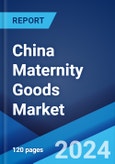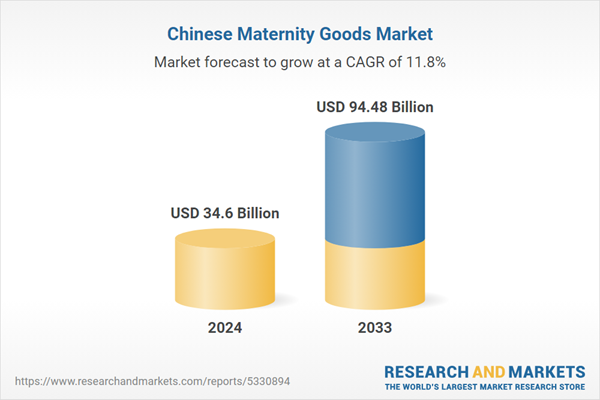The China maternity goods market size was valued at USD 34.64 Billion in 2024. Looking forward, the research estimates the market to reach USD 94.48 Billion by 2033, exhibiting a CAGR of 11.20% from 2025-2033. Guangdong province exhibits a clear dominance in the market due to rising disposable incomes, growing awareness about maternal health, and an increasing number of working women. These factors drive the demand for comfortable, stylish, and high-quality maternity products that cater to both functionality and wellness needs of expectant mothers.
E-commerce platforms are transforming the accessibility and affordability of maternity goods in both urban and rural regions across China. These platforms provide consumers with competitive pricing, convenient home delivery, and an extensive range of products, effectively boosting China maternity goods market share. Additionally, consumer interest in sustainable and organic products has surged, driven by rising awareness of safety and environmental considerations. Manufacturers are responding to this trend by offering eco-friendly maternity goods, such as organic baby clothing, biodegradable diapers, and chemical-free skincare products.
For instance, Pigeon China received the Zero Carbon Exhibition Hall certification from SGS, highlighting its commitment to sustainable business practices. This alignment with evolving consumer preferences, coupled with increasing digital connectivity and trust in online platforms, is fostering sustained market growth. As e-commerce adoption accelerates, these platforms continue to enhance the market landscape by offering tailored product recommendations and improving overall shopping convenience, solidifying their role as key drivers of the maternity goods market.
China Maternity Goods Market Trends:
Growth of E-commerce in Maternity Goods
The e-commerce sector is profoundly transforming the China maternity goods market outlook. With the rapid growth of online shopping platforms, consumers now enjoy easier access to a diverse selection of maternity products, including premium and niche brands. The convenience of online shopping, coupled with features like product reviews, price comparisons, and targeted advertising, is driving demand across both urban and rural regions. Rising internet penetration and smartphone usage are enabling a broader demographic to explore and purchase maternity goods online.Platforms also frequently offer discounts, promotional campaigns, and subscription services, which enhance consumer engagement and loyalty. The integration of artificial intelligence (AI) and data analytics in e-commerce is further personalizing shopping experiences, making it easier for expecting and new parents to find products tailored to their needs.
Increased Demand for Premium Maternity Products
Chinese consumers are demonstrating a growing preference for premium maternity products, driven by higher disposable incomes and a greater focus on quality and safety. Parents are increasingly willing to invest in high-end products such as organic skincare, nutritionally enhanced supplements, and ergonomically designed baby gear to ensure the best care for both mother and child. The rise in luxury baby brands and imported maternity goods reflects this shift toward premiumization.Social media and celebrity endorsements also significantly influence consumer preference, with parents being inspired by trends and recommendations shared online. This trend is encouraging manufacturers to innovate and create products that balance luxury, safety, and functionality, meeting the expectations of an increasingly discerning consumer base.
Emphasis on Sustainability and Eco-friendly Products
The maternity goods market in China is experiencing significant growth in the demand for sustainable and eco-friendly products. With increasing environmental awareness, consumers are prioritizing maternity items made from organic, biodegradable, and non-toxic materials. This trend encompasses products such as eco-friendly diapers, chemical-free skincare, and sustainable baby clothing, reflecting a broader shift toward environmentally responsible choices. For instance, in January 2024, Pigeon launched the "Training Master" baby drink cup series in China, featuring packaging made from 50% sugarcane and 50% wood pulp, showcasing its dedication to sustainability.Moreover, the manufacturers cater to this hike by following sustainable processes in their productions, waste reduction, and using renewable resources. Additionally, government policies and corporate social responsibility initiatives that foster environmental protection also help to align the brand with eco-friendly values. This trend has also gained acceptance among younger parents, such as millennials and Gen Z, who have an inclination towards ethical consumption and sustainability. This is boosting the pace of innovation and competition in the maternity goods market.
China Maternity Goods Industry Segmentation:
The research provides an analysis of the key trends in each segment of the China maternity goods market, along with forecasts at the country and regional levels from 2025-2033. The market has been categorized based on duration, product type, and distribution channel.Analysis by Duration:
- Postnatal Period
- Pregnancy Period
Shifting preferences for customized and organic solutions like herbal supplements and chemical-free skincare are changing the way consumers decide. Furthermore, healthcare providers and wellness programs have boosted their focus on postnatal care, motivating families to spend on holistic product solutions. An accelerating e-commerce platform and enhanced product innovation further strengthen this vital segment.
Analysis by Product Type:
- Nutrients and Health Care Products
- Maternity Wear
- Skin Care Products
- Others
The trend towards natural and organic supplements, free from artificial additives, is further influencing consumer choices. For example, innovations in product formulation and delivery method include gummies, powders, and liquid capsules aimed at improving comfort and attractiveness. As disposable incomes rise, families are willing to invest in premium healthcare solutions, making this segment a cornerstone of the maternity goods market.
Analysis by Distribution Channel:
- Supermarkets and Hypermarkets
- Departmental Stores
- Online
- Brand Stores
- Maternal Stores
- Others
As urbanization increases, modern retail formats are expanding, offering consumers organized shopping environments and access to premium and affordable product options. Dedicated maternity sections, staffed with knowledgeable personnel, enhance the shopping experience. Additionally, partnerships with leading maternity brands ensure that supermarkets and hypermarkets remain pivotal in meeting the diverse needs of the maternity goods market.
Analysis by Province:
- Guangdong
- Jiangsu
- Zhejiang
- Henan
- Sichuan
The consumers in the region prefer quality branded products that are in line with their modern lifestyle and health and safety consciousness. Local government efforts to promote maternal health and wellness also add to the growth of the market. Guangdong's manufacturing capabilities and proximity to major logistics networks make it a critical hub for both production and distribution in the maternity goods sector.
Competitive Landscape:
In China, the competitive landscape of maternity goods is composed of established and emerging players that have a wide array of products to offer. Product innovation, particularly on comfort, design, and functionality, is highly emphasized by companies as they target expectant mothers. Competitive strategies also include expansion in product lines, improvement in online and offline channels of distribution, and marketing efforts that boosts brand awareness.There are heightening concerns towards sustainability practices, such as using environment-friendly materials for products. Due to an escalating number of working mothers, maternity products that are both practical and fashionable, along with versatility, have gained importance and compelled companies to spend on research and development in order to outdo their competition in this competitive marketplace.
The report provides a comprehensive analysis of the competitive landscape in the China maternity goods market with detailed profiles of all major companies, including:
- Health and Happiness (H&H) International Holdings Limited
- Tomson Group Limited
- Real Nutriceutical Group Limited
- Shanghai October Mommy Network Co., Ltd
- Happy House Company
- Mum & Me
- Nanchang Jingqi Clothing Co., Ltd.
- Kangaroo Mother
- Pro Run
- Pigeon Corporatio.
Key Questions Answered in This Report
- How big is the maternity goods market in the China?
- What factors are driving the growth of the China maternity goods market?
- What is the forecast for the maternity goods market in the China?
- Which segment accounted for the largest China maternity goods segment market share?
- Who are the major players in the China maternity goods market?
Table of Contents
Companies Mentioned
- Health and Happiness (H&H) International Holdings Limited
- Tomson Group Limited
- Real Nutriceutical Group Limited
- Shanghai October Mommy Network Co. Ltd
- Happy House Company
- Mum &me
- Nanchang Jingqi Clothing Co. Ltd.
- Kangaroo Mother
- Pro Run
- Pigeon Corporation
Table Information
| Report Attribute | Details |
|---|---|
| No. of Pages | 117 |
| Published | June 2025 |
| Forecast Period | 2024 - 2033 |
| Estimated Market Value ( USD | $ 34.6 Billion |
| Forecasted Market Value ( USD | $ 94.48 Billion |
| Compound Annual Growth Rate | 11.8% |
| Regions Covered | China |
| No. of Companies Mentioned | 10 |









